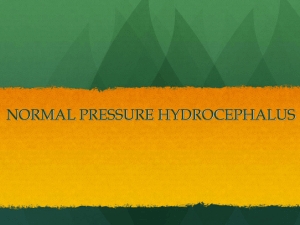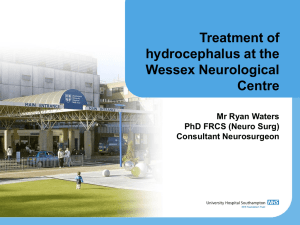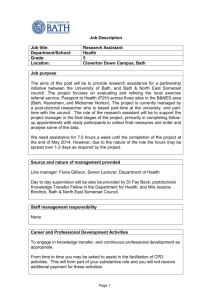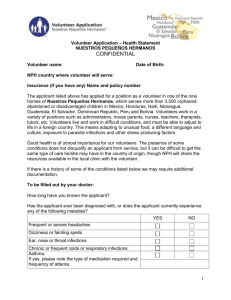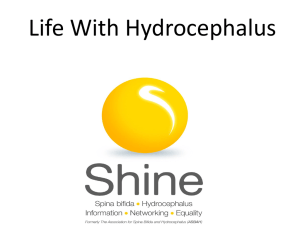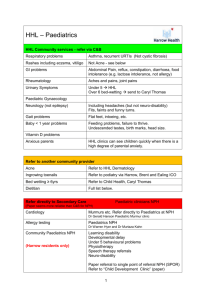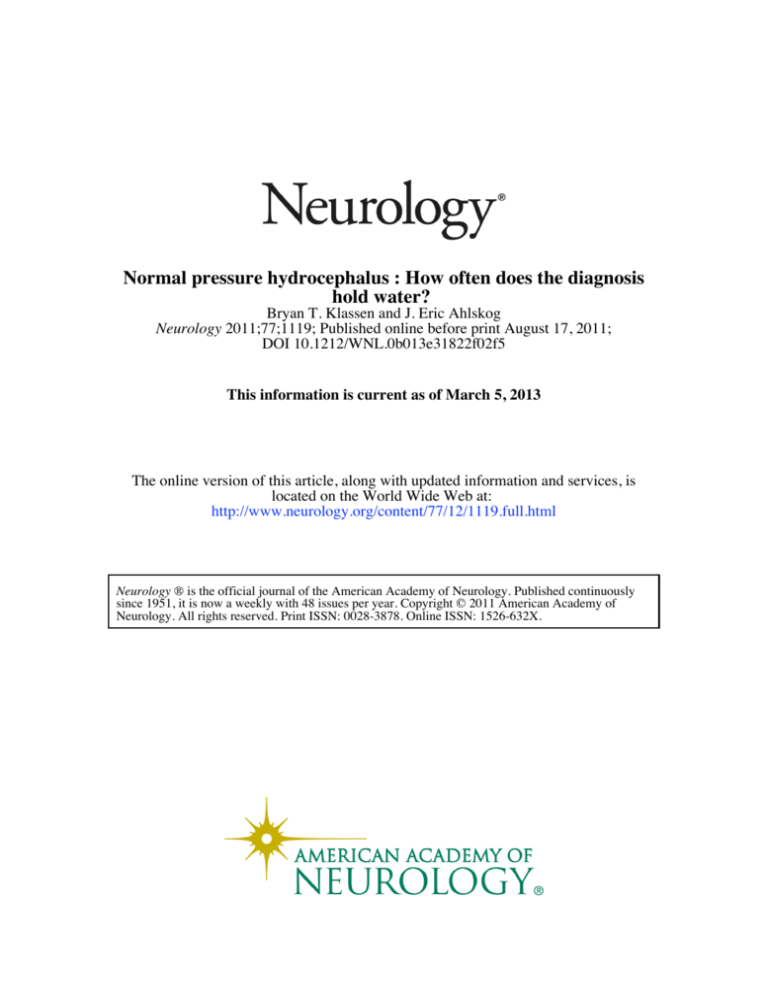
Normal pressure hydrocephalus : How often does the diagnosis
hold water?
Bryan T. Klassen and J. Eric Ahlskog
Neurology 2011;77;1119; Published online before print August 17, 2011;
DOI 10.1212/WNL.0b013e31822f02f5
This information is current as of March 5, 2013
The online version of this article, along with updated information and services, is
located on the World Wide Web at:
http://www.neurology.org/content/77/12/1119.full.html
Neurology ® is the official journal of the American Academy of Neurology. Published continuously
since 1951, it is now a weekly with 48 issues per year. Copyright © 2011 American Academy of
Neurology. All rights reserved. Print ISSN: 0028-3878. Online ISSN: 1526-632X.
ARTICLES
Normal pressure hydrocephalus
How often does the diagnosis hold water?
Bryan T. Klassen, MD
J. Eric Ahlskog, PhD, MD
ABSTRACT
Objective: To determine our community’s incidence of clinically suspected normal pressure hydrocephalus (NPH), the rate of shunting for NPH, and short- and long-term outcomes of shunting.
Address correspondence and
reprint requests to Dr. Bryan T.
Klassen, Department of
Neurology, Mayo Clinic
Rochester, 200 First Street SW,
Rochester, MN 55905
klassen.bryan@mayo.edu
Methods: A retrospective query of the Mayo Clinic medical records linkage system was conducted
to identify residents of Olmsted County, Minnesota, undergoing an invasive diagnostic procedure
for evaluation of suspected NPH from 1995 through 2003. Among patients with shunts, earlyand long-term outcomes were determined via a review of available medical records.
Results: Forty-one patients underwent an invasive diagnostic procedure for evaluation of suspected NPH; 13 ultimately received shunts, representing an incidence of 1.19/100,000/year.
The incidence of sustained definite improvements at 3 years after shunting was only 0.36/
100,000/year. Definite gait improvement was documented in 75% at 3–6 months after shunt
placement, although it dropped to 50% at 1 year and to 33% at 3 years. Only 1 of 8 patients with
cognitive impairment and 1 of 6 patients with urinary incontinence had definite improvement in
these symptoms at 3 years. No patient with moderate to severe postural instability experienced
sustained definite improvement in any symptom. Complications occurred in 33% of patients including one perioperative death. Additional or alternative neurologic diagnoses later surfaced in 5
of 12 patients.
Conclusions: In this community, NPH is relatively rare with an incidence approximating that of
progressive supranuclear palsy in this population. Whereas early gait improvement was common,
only one-third of patients enjoyed continued improvement by 3 years; cognition or urinary incontinence was even less responsive long term. Baseline postural instability predicted poor outcome.
Clinicians should balance potential benefits of shunting against the known risks. Neurology® 2011;
77:1119–1125
GLOSSARY
H-ICDA ! International Classification of Diseases, Adapted Code for Hospitals; NPH ! normal pressure hydrocephalus;
OMC ! Olmsted County Medical Center; PSP ! progressive supranuclear palsy.
Editorial, page 1110
Podcast
The patient presenting with gait disturbance, cognitive decline, or urinary incontinence represents a common clinical dilemma for the practicing neurologist. Although these symptoms are
suggestive of normal pressure hydrocephalus (NPH),1,2 they are not specific to the diagnosis
and commonly occur in neurodegenerative conditions or nonspecifically in advanced age.
Ventriculomegaly, the radiologic hallmark of NPH, frequently accompanies both neurodegenerative disease and normal aging; in practice, it is difficult to determine whether ventricular
enlargement results from hydrocephalus or ex vacuo change. The diagnostic uncertainty in
these patients is particularly problematic, given the invasive nature of treatment for NPH.
Although published guidelines generally support the role of CSF removal trials in assisting with
the diagnosis,3 neither this nor any other test reliably assures sustained benefit from shunting.
In recent years, we have noted an increase in the number of patients referred to our movement
disorders practice for evaluation of possible NPH, perhaps driven partly by increased public
awareness from media coverage and device manufacturer-funded advertising. It was our clinical
From the Department of Neurology, Mayo Clinic Rochester, Rochester, MN.
Study funding: Supported by the National Institute on Aging (grant R01 AG034676).
Disclosure: Author disclosures are provided at the end of the article.
Copyright © 2011 by AAN Enterprises, Inc.
1119
impression that many of these patients were
ultimately not thought to have NPH, often
because alternate diagnoses better explain
their symptoms. This raised the question as
to the true frequency of NPH and, furthermore,
the short- and long-term benefit from shunting.
At Mayo Clinic in Rochester, the previously reported early experience with NPH included a generally favorable early response to
shunting among appropriately selected patients.2 As a result, Mayo Clinic neurologists,
neurosurgeons, and neuroradiologists maintain a high level of vigilance for the clinical
and radiologic signs of NPH. Given our institution’s openness to this diagnosis and its position as our county’s sole neurosurgical
center, we thought that the experience with
NPH in our Olmsted County population
should have general validity. Thus, in this
community-based study, we determined the
following over a 9-year period (1995–2003):
1) the incidence of clinically suspected NPH,
for which the clinician was sufficiently suspicious of the diagnosis to proceed with an invasive procedure (usually lumbar CSF removal);
2) the incidence of shunting for NPH; 3) the
outcomes (both short-term and longterm)
among patients with shunts in Olmsted
County, MN.
METHODS Standard protocol approvals, registrations, and patient consents. Our retrospective chart review
was approved by the Mayo Clinic Institutional Review Board,
and written informed consent for participation in research was
on file for all patients included.
Study population and community referral patterns. Olmsted County, located in southeastern Minnesota, has a population of 124,277, according to the year 2000 national census.
Primary healthcare services are delivered through the Mayo
Clinic, affiliated clinics within Mayo Health Systems, Olmsted
County Medical Center (OMC), and private providers. During
the years covered by the study, neurologic consultations were
only available through the Mayo Clinic Department of Neurology and through a single neurologist at OMC. The Mayo Clinic
remains the county’s sole neurosurgical center, and, for this reason,
the OMC neurologist chose to refer all patients with suspected
NPH to the Mayo Clinic before their undergoing a high-volume
lumbar puncture or other invasive diagnostic procedure.
Case definition. Cases of clinically suspected NPH were operationally defined as those in which a patient underwent an invasive diagnostic or therapeutic procedure for the evaluation or
treatment of suspected NPH; this almost always included a highvolume lumbar puncture, although lumbar cisternography, continuous CSF drainage trials, or ventriculoperitoneal shunting
was also allowed within our definition. At our institution, only
1120
Neurology 77
September 20, 2011
neurologists or neurosurgeons may order these procedures, ensuring that patients falling within our definition would have
been carefully screened for both NPH and competing neurologic
diagnoses. Subjects with a history of congenital hydrocephalus,
CNS hemorrhage, venous sinus thrombosis, CNS infection, or
an obstructing lesion were excluded from analysis.
Patient ascertainment. The Mayo Clinic medical records
linkage system was retrospectively queried to identify Olmsted
County residents who had a clinical encounter between 1995
and 2003 designated with the International Classification of
Diseases, Adapted Code for Hospitals (H-ICDA) diagnostic
codes for NPH, hydrocephalus NOS, communicating hydrocephalus, or occult hydrocephalus. To assure capture of all patients in whom NPH was considered, a computerized search of
the text of all clinical notes covering all county residents during
this time frame was also performed using the terms normal pressure hydrocephalus or communicating hydrocephalus. The
search strategy included primary care notes, allowing capture of
patients primarily managed at Mayo Clinic, who had undergone
surgical intervention outside the county (one such patient was,
indeed, included). The ascertainment period was chosen such
that all relevant clinical notes were accessible for the text-based
search and adequate follow-up time was available at the time of
analysis. The complete medical history of each patient identified
was reviewed to determine whether a high-volume lumbar puncture or other invasive procedure was performed.
Data collection and determination of outcome. For
identified cases, information collected included patient demographics, symptom duration, the presence or absence of each
element of the NPH triad, the degree of postural instability, and
the radiologist’s impression of neuroimaging studies. For patients undergoing shunting, early (3– 6 months) and late (3
years) outcomes were retrospectively determined by a comprehensive chart review to the last available follow-up. Based on the
documented impressions of the treating neurologist, the patient,
and the patient’s family, outcomes were rated for each element of
the clinical triad as follows: 0, no improvement beyond presurgical baseline; ", equivocal improvement; #, definite improvement but significant residual symptoms; or ##, normalization
or near-normalization. In the case of a decline in patient status,
the time to decline was determined using the date of the clinical
assessment at which the decline was first documented. Complications of the shunting procedure were tabulated. Additional
neurologic diagnoses made during follow-up were noted, as were
the results of neuropathologic examination when available.
Determination of incidence rates. Population denominators used in the calculation of incidence rates were determined
by a linear interpolation of the decennial census data with a
1.9% projected growth rate after 2000. Average annual incidence rates (incidence per 100,000 person-years) were calculated
for both the entire population and for the population aged
50 –99 years. Because the study covered the entire target population, no sampling was involved, and, therefore, no statistical testing was applied during interpretation of the data.
RESULTS The H-ICDA database query returned
247 patients; 164 additional patients were discovered
using the text-based search. From the 411 total records reviewed, 41 patients meeting the inclusion/
exclusion criteria were identified; the remainder were
patients with congenital or secondary hydrocephalus
or patients in whom the treating clinician’s note explicitly dismissed NPH as a likelihood (such cases
were flagged by the text-based search). All patients in
whom NPH was felt to be the likely diagnosis were
referred for invasive diagnostic testing. These 41 patients correspond to an incidence rate for clinically
suspected NPH of 3.74/100,000/year for the total
population and 15.20/100,000/year for the population older than 50 years.
Among the 41 patients with suspected NPH, all
had gait disturbance, 30 had cognitive impairment,
and 14 had urinary incontinence. Twenty of the 41
presented with 2 key symptoms, and 12 presented
with all 3 elements of the NPH triad. Nineteen were
found to have moderate to severe postural instability,
defined by a positive pull test. Neuroimaging results
were available for the 40 patients undergoing the invasive procedure at Mayo Clinic and, in all patients,
documented ventriculomegaly.
Our practice has been to offer shunt placement
only to patients with objective gait improvement after a trial of CSF removal. Of the 38 patients undergoing high-volume lumbar puncture, 14 experienced
gait improvement, and 11 subsequently underwent
ventriculoperitoneal shunting. Among the 3 of the
14 patients who did not undergo shunting, one had a
history of carbon monoxide exposure and was later
diagnosed with levodopa-responsive parkinsonism,
another had a history of stroke, failed to appear for
the neurosurgical evaluation, and was later diagnosed
with multi-infarct dementia, and the third had a history of schizophrenia and declined neurosurgical intervention. Among the 41 patients with suspected
NPH, 2 did not undergo a trial of CSF removal but
underwent other invasive procedures. One underwent lumbar cisternography with results not consistent with the diagnosis; hence, this patient did not
undergo shunting. The other (case 1) was taken directly for ventriculoperitoneal shunting on the basis
of gait dysfunction, urinary incontinence, and imaging studies thought to be highly typical of NPH. Finally, one patient underwent ventriculoperitoneal
shunting at the regional Veterans Affairs Medical
Center, and outcome data for that patient were unavailable; this patient is included in the epidemiology
but not outcomes sections of this study.
Of the 41 patients in whom suspicion for NPH
was sufficient to justify an invasive diagnostic or therapeutic procedure, 13 (32%) ultimately underwent
ventriculoperitoneal shunting (table). This corresponds to a shunted NPH incidence rate of 1.19/
100,000/year for the total population and 4.82/
100,000/year for those older than 50 years. The
mean age at the time of shunting was 78.5 years
(range 66 – 85 years). The gender distribution was
nearly equal with 6 (46%) women and 7 (54%) men
having undergone shunting. The average duration of
symptoms before shunting was 2.4 years (range 0.4 –
7.0 years). All 13 patients undergoing shunting had
gait disturbance; 8 also had cognitive dysfunction
and 6 had urinary incontinence. Six patients presented with 2 of the 3 symptoms, but only 4 patients
presented with all elements of the classic NPH triad.
Postural instability was absent in 4 patients, mild in 3
patients, and moderate to severe in 6 patients.
Outcome data were available for all 12 patients
who underwent shunting at the Mayo Clinic. At 3– 6
months postprocedure, 9 of these (75%) demonstrated definite gait improvement; 2 did not respond
to shunting, and 1 died in the perioperative period.
By 1 year, only half (6 of 12) experienced definite
gait improvement and by the 3-year endpoint only
one-third (4 of 12) maintained definite improvement, whereas 5 of the original 9 responders (45%)
had a decline in gait response. One of these (case 7)
was found to have orthostatic myoclonus as a possible contributor to gait decline, although no new
causes of gait dysfunction were present in the remaining 4. None of the 6 patients with moderate to
severe postural instability experienced definite improvement in gait at the last follow-up. In cases 6, 9,
and 10, the length of follow-up was less than 3 years;
however, in each of these patients the benefit from
shunting had already waned before the time of last
follow-up, and shunt dysfunction or unrelated causes
of gait dysfunction were considered and ruled out
using appropriate studies. It was assumed that spontaneous improvement would not subsequently occur,
and the clinical status at the last follow-up was carried forward for these 3 patients. Of the 8 patients
with cognitive impairment, 4 (50%) demonstrated
definite early cognitive improvement after shunting,
but only 1 (13%) sustained improvement at 3 years.
Similarly, of the 6 patients with urinary incontinence, 3 (50%) demonstrated definite early improvement in urinary symptoms after shunting, but only 1
(16%) sustained improvement at 3 years. If the patient who died perioperatively is removed from the
denominator, favorable outcomes improve in the
short term to 9 of 11 (82%) for gait and 4 of 7 (57%)
for cognition and in the long term to 4 of 11 (36%)
for gait and 1 of 7 (14%) for cognition. No new
causes of cognitive decline or incontinence were
found during life for any of the patients whose initial
response to these symptoms waned.
No patient had definite improvement in cognition or urinary incontinence without concomitant
definite improvement in gait at the same time point;
therefore, gait outcomes were used to gauge the overall success of shunting. There was no clear relationNeurology 77
September 20, 2011
1121
1122
Neurology 77
September 20, 2011
Age,
y
70
75
85
76
85
76
77
82
85
66
1
2
3
4
5
6
7
8
9
10
F
M
F
M
M
M
M
F
F
F
Sex
3.1
1
1.1
0.4
2
3.4
2
1.3
4
7
Symptom
duration,
y
#
#
#
#
#
#
#
#
#
#
Gait
disturbance
#
#
#
#
#
#
Cognitive
decline
Baseline symptoms
#
#
#
#
#
#
Urinary
incontinence
#
0
#
"
#
#
"
0
"
0
Postural
instability
"
#
#
#
#
#
#
#
#
##
Shortterm (3–
6 mo)
0.4
0.4
0b
b
0
0.9
0
0.7
1.6
"b
"
2.5
4.6
No
decline
No
decline
No
decline
Time to
decline,
y
0
#
#
#
##
Longterm
(3 y)
Gait outcomes
Thirteen Olmstead County residents receiving shunts for NPH from 1995 to 2003a
Case
Table
0
0
0
"
"
0
"
#
#
##
Last
follow-up
2.5
0.5
6.2
5.6
1.9
5.9
6.5
4.6
9
3
Length
of
followup, y
0
#
0
#
#
#
Shortterm
0
0b
0
"b
0
#
Longterm
Cognitive
outcomes
0
#
0
0
#
#
Shortterm
0
0
0
0
#
"
Longterm
Urinary
incontinence
outcomes
Traumatic
subdural
hematoma
1 mo
after shunt
Seizure 2 y
after shunt
Seizure 4 mo
after shunt
Complications
—Continued
Clinical diagnosis
of Lewy body
dementia
Pathologically
confirmed
progressive
supranuclear palsy
Electrophysiologically
confirmed orthostatic
myoclonus;
argyrophilic grain
disease on
pathology
Pathologic diagnosis
of argyrophilic grain
disease and Braak
and Braak stage IV
Alzheimer type
changes
Later diagnoses
0
0
4.5
0
Perioperative death
Data not availablec
#
0
No
decline
0
0
#
#
#
#
81
13
M
1.2
81
12
M
#
#
2.6
11
F
82
Case
Sex
Age,
y
Abbreviation: NPH ! normal pressure hydrocephalus.
a
Demographics, baseline clinical information, and postshunt outcomes are shown for the 13 Olmstead County residents undergoing ventriculoperitoneal shunting for treatment of NPH (1995–2003), organized
from best to worst outcome. The duration between the first presenting symptom consistent with NPH and the time of shunt placement is shown. The degree of postural instability was assessed with the pull test: 0,
normal response; ", recovers after initial retropulsion. #, does not recover. Postoperative outcomes for each element of the NPH triad at early (short-term, 3–6 months) and late (long-term, 3 years) time points are
denoted as follows: 0, no improvement beyond preoperative baseline; ", equivocal improvement; #, definite improvement but significant residual deficits, ##, normalization or near-normalization. Gait outcomes
at the last available follow-up are similarly denoted. For patients whose gait declined after an initial improvement, the time to decline is noted.
b
Three patients (cases 6, 9, and 10) had less than 3 years total follow-up and outcomes at the last available follow-up were carried forward.
c
One patient (case 13) received care outside of Olmstead County, and outcome data are not available.
Death from
perioperative
pulmonary
embolism/acute
respiratory
distress
syndrome
Clinical diagnosis of
multi-infarct dementia
Later diagnoses
Complications
Longterm
Shortterm
Longterm
Longterm
(3 y)
Shortterm (3–
6 mo)
Symptom
duration,
y
Gait
disturbance
Cognitive
decline
Urinary
incontinence
Postural
instability
Time to
decline,
y
Last
follow-up
Length
of
followup, y
Shortterm
Urinary
incontinence
outcomes
Cognitive
outcomes
Gait outcomes
Baseline symptoms
Continued
Table
ship between symptom duration and shunt response;
in fact, the patient with the longest symptom duration (7 years) was among the best responders. The
incidence rate for a sustained definite improvement
in any symptom at 3 years after shunting was 0.36/
100,000/year for the total population and 1.65/
100,000/year for those older than 50 years.
Complications probably related to shunt placement were experienced by 4 of the 12 patients with
shunts (33%). One developed a pulmonary embolism days after the surgery, resulting in acute respiratory distress syndrome to which the patient
eventually succumbed. A traumatic subdural hematoma requiring surgical drainage occurred 1 month
after shunting in another patient. Two patients experienced epileptic seizures, one at 14 months and the
other at 2 years after shunt placement.
Alternative or additional neurologic diagnoses
were later given to 5 of the 12 patients with shunts
(42%). These included a clinical diagnosis of dementia with Lewy bodies in case 10 and multi-infarct
dementia in case 11. Electrophysiologically confirmed orthostatic myoclonus was subsequently identified as contributing to the gait problems of case 7,
and on subsequent postmortem examination, the patient was found to have argyrophilic grain disease. In
case 5, a second pathologically confirmed diagnosis
of argyrophilic grain disease was noted in association
with Braak and Braak stage IV, National Institute on
Aging–Reagan intermediate likelihood Alzheimer
pathology. Finally, postmortem examination of case
8 revealed progressive supranuclear palsy (PSP)
neuropathology. None of the patients given an additional neurologic diagnosis after shunting experienced definite improvement in any symptom at
3 years.
DISCUSSION
Although NPH is often high on the
differential diagnosis for seniors with gait problems,
our community-based data suggest that 1) clinical
and neuroimaging features highly suggestive of NPH
are relatively uncommon and 2) most patients originally suspected of having NPH do not respond to a
CSF removal trial. The relatively low incidence of
shunting for NPH approximates that of PSP in this
county.4 Similarly, low incidence figures have been
described in several European reports.5–9 Conversely,
relatively high prevalence figures (0.4%–14%) have
been estimated when members of a population are
screened for compatible clinical or neuroimaging features.10 –14 Because these findings are nonspecific,
studies that simply tabulate gait disturbance, dementia, incontinence, and ventriculomegaly without
broader reference to the overall clinical context probably overestimate NPH prevalence. In contrast, our
Neurology 77
September 20, 2011
1123
study captured only those thought to have NPH in
the context of a thorough neurologic evaluation. It is
possible some residents with NPH were initially
managed by non–Mayo Clinic primary providers
who then referred out of county, causing our incidence rate to be falsely low. However, given our
community’s high index of suspicion for this diagnosis and its usual referral patterns including residents’
ready access to neurologists, we believe our ascertainment is as ideal as possible.
In our series, initial responses to ventriculoperitoneal shunting were quite promising although usually
were not sustained. Objective measures were not uniformly available; thus, our study is limited by the
retrospective and somewhat subjective nature of outcome determination. However, because all parties
were significantly invested in the procedure and
hoped for a benefit, we think it unlikely that the
documented observations of the patients, family
members, and treating clinicians significantly underestimate efficacy. To our knowledge, the present
study represents the only community-based series in
which long-term outcomes are addressed. Three- to
5-year outcomes have been reported in several
referral-based series which, in keeping with our observations, generally report initial response rates
greater than 70%. Some series report significant decline among initial responders,2,15–18 whereas others
have shown that improvements are largely sustained
over time.19 –23 For several of these series, the loss to
follow-up was substantial. Patients whose mobility
deteriorates or who require placement in extended
care facilities may be less able to return to their original surgical center, introducing a substantial source
of bias. In contrast, we were able to assess outcomes
among this subset.
Nearly half of our patients were later given an
alternative neurologic diagnosis, and none of these
realized sustained definite improvements after shunting. Whether they truly had NPH before developing
a second neurologic disease is difficult to determine.
However, it seems likely that in some, in particular
the patient with pathologically proven PSP, the laterdiagnosed disorder had been responsible for the entire clinical picture. All 3 patients undergoing brain
autopsy had neuropathologic findings of neurodegenerative disease, consistent with observations that
more than two-thirds of patients receiving shunts for
NPH have one or more pathologic markers of Alzheimer disease, and those with a moderate to severe
Alzheimer disease burden are significantly less likely
to respond to shunting.24 However, a favorable early
response does not exclude an underlying neurodegenerative condition, as evidenced by our patient
with PSP who had early, albeit transient, improve1124
Neurology 77
September 20, 2011
ments after shunting. It is clear that careful diagnostic testing for alternative diagnoses is advisable before
shunting; because newer techniques are able to diagnose neurodegenerative disease at earlier stages, the
overall response to shunting may improve simply because of a shrinking denominator.
It is noteworthy that no patient with moderate to
severe postural instability showed long-term definite
improvement after shunting, and 4 of these 5 (excluding the patient who died perioperatively) were
later given an additional neurologic diagnosis. Earlier
reports have also suggested that imbalance is not
likely to respond to CSF removal.25,26 It may be that
this symptom is a hallmark of underlying neurodegenerative disease. Because postural instability is
quite disabling, it is often the symptom initially
prompting evaluation; our experience suggests that
shunting is probably not the best course of action for
these patients.
Patients and their families often perceive shunting
to be a simple, safe procedure. However, it is not
without risk. In our series, 1 patient experienced
perioperative death and 3 more developed complications precipitated by the procedure. The one-third of
our patients (4 of 12) with complications is in keeping with the 38% complication rate reported in a
systematic review of prior series.16 Given that improvements after shunting for suspected NPH are often short-lived and given the significant potential for
shunt-related complications, clinicians advising these
patients need to remain mindful of the diagnostic
limitations and maintain a reasonable perspective on
the potential benefits of invasive CSF diversion.
AUTHOR CONTRIBUTIONS
Dr. Klassen: drafting/revising the manuscript, study concept or design,
analysis or interpretation of data, acquisition of data, and statistical analysis. Dr. Ahlskog: drafting/revising the manuscript, study concept or design, analysis or interpretation of data, and study supervision.
DISCLOSURE
Dr. Klassen reports no disclosures. Dr. Ahlskog received the Fred Springer
Award from the American Parkinson’s Disease Association; serves on the
editorial boards of Parkinsonism and Related Disorders and Clinical Neuropharmacology; receives royalties from the publication of The Parkinson’s
Disease Treatment Book (Oxford University Press, 2005), Parkinson’s Disease Treatment Guide for Physicians (Oxford University Press, 2009), Parkinson’s Disease and Movement Disorders (Humana Press, 2000), and
Surgical Treatment of Parkinson’s Disease and Other Movement Disorders
(Humana Press, 2003); and receives research support from NIH/NINDS.
Received January 7, 2011. Accepted in final form April 20, 2011.
REFERENCES
1. Adams RD, Fisher CM, Hakim S, Ojemann RG, Sweet
WH. Symptomatic occult hydrocephalus with “normal”
cerebrospinal-fluid pressure: a treatable syndrome. N Engl
J Med 1965;273:117–126.
2.
3.
4.
5.
6.
7.
8.
9.
10.
11.
12.
13.
Petersen RC, Mokri B, Laws ER Jr. Surgical treatment of
idiopathic hydrocephalus in elderly patients. Neurology
1985;35:307–311.
Marmarou A, Bergsneider M, Klinge P, Relkin N, Black
PM. The value of supplemental prognostic tests for the
preoperative assessment of idiopathic normal-pressure hydrocephalus. Neurosurgery 2005;57:S17–S28.
Bower JH, Maraganore DM, McDonnell SK, Rocca WA.
Incidence of progressive supranuclear palsy and multiple
system atrophy in Olmsted County, Minnesota, 1976 to
1990. Neurology 1997;49:1284 –1288.
Brean A, Eide PK. Prevalence of probable idiopathic normal pressure hydrocephalus in a Norwegian population.
Acta Neurol Scand 2008;118:48 –53.
Brean A, Fredo HL, Sollid S, Muller T, Sundstrom T,
Eide PK. Five-year incidence of surgery for idiopathic normal pressure hydrocephalus in Norway. Acta Neurol
Scand 2009;120:314 –316.
Tisell M, Hoglund M, Wikkelso C. National and regional
incidence of surgery for adult hydrocephalus in Sweden.
Acta Neurol Scand 2005;112:72–75.
Krauss JK, Halve B. Normal pressure hydrocephalus: survey on contemporary diagnostic algorithms and therapeutic decision-making in clinical practice. Acta Neurochir
2004;146:379 –388.
Vanneste J, Augustijn P, Dirven C, Tan WF, Goedhart
ZD. Shunting normal-pressure hydrocephalus: do the benefits outweigh the risks? A multicenter study and literature
review. Neurology 1992;42:54 –59.
Marmarou A, Young HF, Aygok GA. Estimated incidence
of normal pressure hydrocephalus and shunt outcome in
patients residing in assisted-living and extended-care facilities. Neurosurg Focus 2007;22:E1.
Trenkwalder C, Schwarz J, Gebhard J, et al. Starnberg trial
on epidemiology of Parkinsonism and hypertension in the
elderly: prevalence of Parkinson’s disease and related disorders assessed by a door-to-door survey of inhabitants older
than 65 years. Arch Neurol 1995;52:1017–1022.
Hiraoka K, Meguro K, Mori E. Prevalence of idiopathic
normal-pressure hydrocephalus in the elderly population
of a Japanese rural community. Neurol Med Chir 2008;
48:197–199.
Iseki C, Kawanami T, Nagasawa H, et al. Asymptomatic
ventriculomegaly with features of idiopathic normal pressure hydrocephalus on MRI (AVIM) in the elderly: a prospective study in a Japanese population. J Neurol Sci 2009;
277:54 –57.
14.
Tanaka N, Yamaguchi S, Ishikawa H, Ishii H, Meguro K.
Prevalence of possible idiopathic normal-pressure hydrocephalus in Japan: the Osaki-Tajiri project. Neuroepidemiology 2009;32:171–175.
15. Malm J, Kristensen B, Stegmayr B, Fagerlund M, Koskinen LO. Three-year survival and functional outcome of
patients with idiopathic adult hydrocephalus syndrome.
Neurology 2000;55:576 –578.
16. Hebb AO, Cusimano MD. Idiopathic normal pressure hydrocephalus: a systematic review of diagnosis and outcome.
Neurosurgery 2001;49:1166 –1184.
17. Savolainen S, Hurskainen H, Paljarvi L, Alafuzoff I, Vapalahti M. Five-year outcome of normal pressure hydrocephalus with or without a shunt: predictive value of the
clinical signs, neuropsychological evaluation and infusion
test. Acta Neurochir 2002;144:515–523.
18. Kahlon B, Sjunnesson J, Rehncrona S. Long-term outcome in patients with suspected normal pressure hydrocephalus. Neurosurgery 2007;60:327–332.
19. Raftopoulos C, Massager N, Baleriaux D, Deleval J,
Clarysse S, Brotchi J. Prospective analysis by computed
tomography and long-term outcome of 23 adult patients
with chronic idiopathic hydrocephalus. Neurosurgery
1996;38:51–59.
20. Mori K. Management of idiopathic normal-pressure hydrocephalus: a multiinstitutional study conducted in Japan. J Neurosurg 2001;95:970 –973.
21. Aygok G, Marmarou A, Young HF. Three-year outcome
of shunted idiopathic NPH patients. Acta Neurochir
Suppl 2005;95:241–245.
22. Tisell M, Hellstrom P, Ahl-Borjesson G, et al. Long-term
outcome in 109 adult patients operated on for hydrocephalus. Br J Neurosurg 2006;20:214 –221.
23. Pujari S, Kharkar S, Metellus P, Shuck J, Williams MA,
Rigamonti D. Normal pressure hydrocephalus: long-term
outcome after shunt surgery. J Neurol Neurosurg Psychiatry 2008;79:1282–1286.
24. Hamilton R, Patel S, Lee EB, et al. Lack of shunt response
in iNPH with AD pathology. Ann Neurol 2010;68:535–
540.
25. Stolze H, Kuhtz-Buschbeck JP, Drucke H, et al. Gait analysis in idiopathic normal pressure hydrocephalus: which
parameters respond to the CSF tap test? Clin Neurophysiol 2000;111:1678 –1686.
26. Bugalho P, Guimaraes J. Gait disturbance in normal pressure hydrocephalus: a clinical study. Parkinsonism Relat
Disord 2007;13:434 – 437.
Neurology® Launches Subspecialty Alerts by E-mail!
Customize your online journal experience by signing up for e-mail alerts related to your subspecialty
or area of interest. Access this free service by visiting http://www.neurology.org/site/subscriptions/
etoc.xhtml or click on the “E-mail Alerts” link on the home page. An extensive list of subspecialties,
methods, and study design choices will be available for you to choose from—allowing you priority
alerts to cutting-edge research in your field!
Neurology 77
September 20, 2011
1125
Normal pressure hydrocephalus : How often does the diagnosis hold water?
Bryan T. Klassen and J. Eric Ahlskog
Neurology 2011;77;1119; Published online before print August 17, 2011;
DOI 10.1212/WNL.0b013e31822f02f5
This information is current as of March 5, 2013
Updated Information &
Services
including high resolution figures, can be found at:
http://www.neurology.org/content/77/12/1119.full.html
Supplementary Material
Supplementary material can be found at:
http://www.neurology.org/content/suppl/2011/09/16/WNL.0b01
3e31822f02f5.DC1.html
References
This article cites 26 articles, 5 of which can be accessed free at:
http://www.neurology.org/content/77/12/1119.full.html#ref-list1
Citations
This article has been cited by 3 HighWire-hosted articles:
http://www.neurology.org/content/77/12/1119.full.html#relatedurls
Subspecialty Collections
This article, along with others on similar topics, appears in the
following collection(s):
All Cognitive Disorders/Dementia
http://www.neurology.org/cgi/collection/all_cognitive_disorder
s_dementia
Gait disorders/ataxia
http://www.neurology.org/cgi/collection/gait_disorders_ataxia
Hydrocephalus
http://www.neurology.org/cgi/collection/hydrocephalus
Incidence studies
http://www.neurology.org/cgi/collection/incidence_studies
Permissions & Licensing
Information about reproducing this article in parts (figures,
tables) or in its entirety can be found online at:
http://www.neurology.org/misc/about.xhtml#permissions
Reprints
Information about ordering reprints can be found online:
http://www.neurology.org/misc/addir.xhtml#reprintsus

